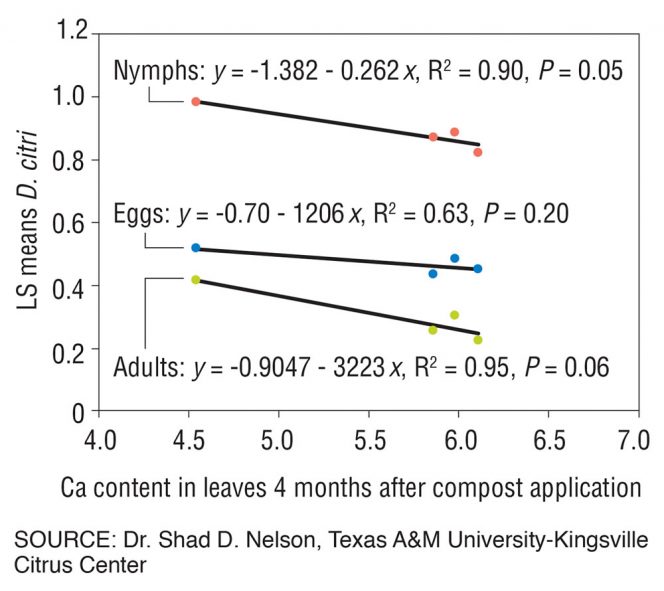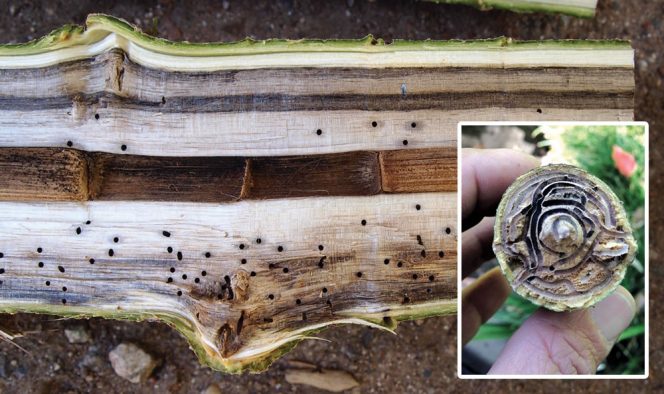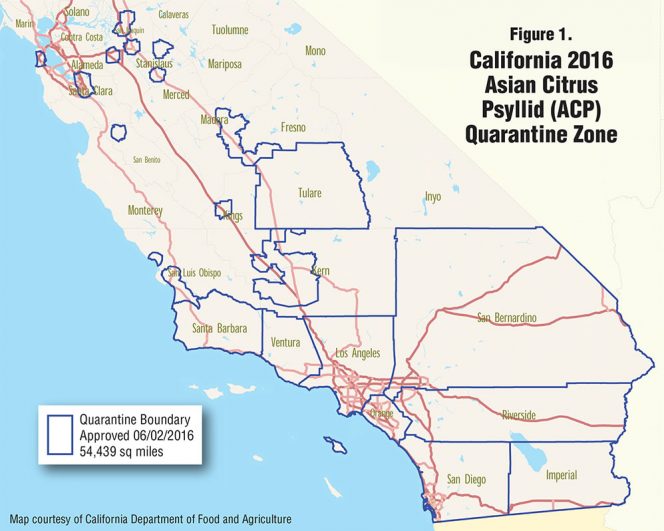Composting and mulching facilities in California and Washington contend with quarantines and green waste management requirements to prevent further spread of pests.
Craig Coker
BioCycle July 2016
The potential damage to U.S. agriculture is particularly concerning. California, with estimated annual agricultural losses of $3 billion, and global trade facilities handling about 40 percent of the nation’s incoming containerized cargo (a major source of invasive pests), could be considered “ground zero” in the fight against invasive pests. The California Department of Food and Agriculture (CDFA) currently has quarantine areas set up inside the state for 25 different invasive insect pests. Some infect trees that end up being trimmed, and thus the trimmings can end up in the California green waste stream, both at mulching (chip-and-grind) and composting facilities.
California is not alone in this battle. Recent episodes of invasive pests in green wastes have also affected composting and mulching facilities in other states. In Washington State, the apple maggot (Rhagoletis pomonella) has infected apple and hawthorn trees and led to bans on the movement of green materials from the population centers of Western Washington to the apple-growing regions of Central Washington, where several composting facilities are located.
The Asian Citrus Psyllid (Diaphorina citri) transmits the incurable bacterial disease “huanglongbing” (HLB), also known as citrus greening. In less than a decade, citrus greening has spread through Florida and become established in Georgia, Alabama, Mississippi, Louisiana, Texas, northwest Arizona, and now California. According to University of Florida research, the disease cost the state of Florida more than $4.5 billion in lost citrus production. It also increases production costs for citrus that does grow. Florida orange production declined from 133 million boxes in 2013 to less than 70 million in 2016, with an attendant loss of 8,200 jobs. At present, the USDA’s Animal and Plant Health Inspection Service has a federal quarantine on interstate shipment of citrus nursery stock from the quarantine areas.
Another new pest in California, the polyphagous shot hole borer (PSHB), attacks iconic native trees such as oaks and sycamores, as well as commercial avocado groves. This tiny beetle, not much bigger than a sesame seed, spreads a Fusarium fungus that kills branches, crowns and often the entire tree. Because this bug spends almost its entire life in the tree, it is difficult to trap or kill. Therefore California has not implemented a quarantine to restrict movement of potentially PSHB-infested materials, including firewood. The single best method to prevent its spread is by education of and voluntary cooperation from all players in the green materials handling community.
These invasive pests become a problem to the composting industry as the trimmings from the sick and infested trees find their way into the green waste stream. Where infestations are known to occur, composters have had to enter into compliance agreements or been banned from receiving potentially infested green wastes. At the recent BioCycle WEST COAST16 Conference in San Diego (www.BioCycleWestCoast.com), two sessions covered invasive pests, with speakers discussing both research and management approaches to the problem.
Regulating The Infestations
Quarantine zones are the primary regulatory tool to address invasive pests. USDA has regulatory authority to set up international and interstate quarantines. State Departments of Agriculture usually have regulatory authority to set up a quarantine zone inside the state. In California, CDFA has authority to set up State Interior Quarantines, non-USDA interstate quarantines, and to authorize County Agricultural Commissioners to set up quarantine zones covering all or portions of that county.
California Green Waste Quarantines
In California, pest quarantine zones consist of: identifying the pest, the area under quarantine (which can be as fine-grained as block-by-block in an urban area), and those articles regulated under the quarantine, and establishing restrictions on how regulated articles can be moved. For all regulated industries in the quarantine zone (i.e. growers, harvesters, processors, packers and transporters of affected agricultural commodities; green waste industry participants; production and retail nurseries; and fruit sellers and community gardens), compliance agreements are established between an entity and local county Agricultural Commissioners, who have delegated authority from CDFA. For the ACP quarantine zone, there are over 500 compliance agreements in place.
Composting facilities in California that receive green waste from inside a quarantine zone must have a Quarantine Compliance Agreement, in which a facility owner or manager agrees to comply with all quarantine rules and requirements for the regulated articles in that quarantine zone. If the receiving facility is outside the quarantine zone, then the facility must be approved by the local county Agricultural Commissioner. This requirement applies only to green waste, where “green waste” is defined as “unprocessed or processed vegetative material which contains any of the following or a mixture thereof: stems, leaves, culls, discarded fruits and vegetables, grass clippings, weeds, yard trimmings, wood/vine/processing/harvesting waste, hulls, bark, branches, logs and stumps, home garden/field/vineyard/grove/orchard residues, duff, mulch, compost and other miscellaneous plant materials.”
In general, all entities in the chain of custody for green materials from a quarantine zone need a compliance agreement, which lays out the steps or procedures which a hauler or handler must take to prevent the spread of the pest and to operate legally. Ideally, a solid waste hauler (operating under a compliance agreement) will take quarantined materials to a transfer station, which also operates under a compliance agreement. The materials are aggregated and put into a larger truck, also operating under a compliance agreement, which takes the materials to a composting facility — their final destination — that operates under a compliance agreement. Once material has been composted, with few exceptions, it may be distributed without further concern.
Nuances occur in places like Los Angeles, where as many as a half dozen quarantines for different pests in different areas may be in place at any one time, and it may be nearly impossible to determine which materials at a transfer station or chip and grind facility came from a quarantine zone. In such cases, commingled materials should be treated as if they contained pests. Additional opportunities for system failure occur when materials are generated in one county but processed in another. Perhaps the greatest risk of all occurs when green materials, some potentially from quarantined zones, are chipped and shipped as mulch or destined for direct application to farm land without composting. Violations of a Quarantine Compliance Agreement have potential criminal penalties of a fine of $1,000 per day and a misdemeanor conviction, and significant civil penalties of up to a $10,000 fine per violation (i.e. per truckload of regulated articles moved out of the quarantine zone).
“Unfortunately, we have had to impose those penalties for violations of our Quarantine Compliance permits,” Duane Schnabel, Chief of the Pest Exclusion Branch of CDFA, told the assembled BioCycle Conference audience. “One of our great challenges in California is that our urban centers are the source of most green waste and also the more frequent areas to have quarantine zones, but our composting facilities are located outside the quarantine areas. This sets up the potential for permit violations.”
Robert Horowitz, Supervisor of the Organics Management and Construction & Demolition Unit at CalRecycle, outlined similarities in compliance agreements for various green waste handlers to Conference attendees: “Compliance agreements generally require quarantined materials to be kept covered during transport and after tipping. Grind the green waste as quickly and as small as possible. Move it into a composting pile as quickly as possible, no more than 72 hours after receipt. Make sure you can prove you met the time-temperature requirements. Finally, suspect materials should go to composting, and should never be used as mulch.”
Managing Infestations In California
California has committed to increasing its source reduction, recycling and composting rate to 75 percent by 2020, which will require significant expansion of composting and mulching infrastructure. Composting facilities in the state are subject to stringent regulations on air emissions and storm water discharges; these constraints do not (currently) apply to the mulching industry. Consequently, the cost differences between composting and mulching have increased, making mulching and its cousin — direct application of ground, uncomposted green materials to agricultural land — economically attractive. From a pest perspective, this increases the risk of spread.
Mulching facilities (also known as chip-and-grind facilities in California) may not kill invasive pests in green waste due to the lack of adequate time-temperature relationships. Under California regulations, composting facilities must reach 55°C (131°F) and hold that temperature for a minimum of three days for insulated static piles, and 15 days/5 turns for windrow operations. Chip-and-grind facilities cannot legally meet this standard because they may not allow materials on site to exceed 131°F due to the potential for spontaneous combustion. Also, they generally must remove all ground material from the site within 48 hours of delivery. Fine grinding can reduce populations of larger pests such as moths, but is not proven effective against all life stages of pests or against smaller, tougher pests such as PHSB.
Researchers at the University of California–Riverside have been investigating this potential problem by creating field simulations of different size reduction regimes (no size reduction, chipping and grinding), different management approaches (isolated from other feedstocks and composted with other feedstocks), different temperature regimes (25°C and 55°C), and different residence times (0 and 3 days). They tested different plant and weed seeds (nutsedge, clover, tomato, Bermuda grass), insects (ACP and Citrus Leafminer), viruses (tobacco mosaic virus or TMV) and fungi (Fusarium).
The initial results showed that: composting was better than just isolating the feedstock; chipping had some beneficial effects on some insects; and composting at 55°C inactivated all testing subjects except TMV. Other researchers at UC-Riverside found that chipping green waste to less than one inch and exposing it to solarizing temperatures above 33°C (95°F) in summer months is an effective treatment for PSHB.
Working With LEAs
CalRecycle has focused its recent quarantine-related efforts on building relationships between Local Enforcement Agencies (LEAs) — the county Environmental Health Department personnel who inspect composting and chip and grind facilities — and their counterparts at the county Agricultural Commissioner’s office. Building these relationship will raise awareness with the LEAs regarding quarantine issues and new pests, as well as with commissioner personnel in understanding the sometimes complex movement of green materials and who the key players are.
One place where greater cooperation has already paid off is in Santa Clara County. Located in the southern part of the San Francisco Bay area, the county is considered a “gateway” for pest infestations due to the high amount of global traffic it receives. Infestations in Santa Clara County include ACP, sudden oak death, fruit flies, and Japanese beetles. The county’s Agricultural Commissioner, Joe Deviney, and the county’s Solid Waste Program Manager, Paul Tavares, have teamed up to educate composters, and the public, on the need for proper management of potentially-infested green wastes.
“Paul and I have been doing some joint inspections lately,” Deviney explains. “I get to learn more about the organics recycling industry in our County. The Solid Waste program staff have good relationships with the green waste managers and I can use these inspections to review the regulations, alert them to current quarantines, and let them know about emerging pest problems.” One potential outcome of this outreach is for composters to recognize incoming green waste feedstocks from infested areas and move those loads to the front of their processing queues, so that infested green waste would get composted more quickly.
Compost As Preventive Medicine
Dr. Shad Nelson presented in the infestation research session at BioCycle WEST COAST16 on work that he and his team at Texas A&M University–Kingsville Citrus Center conducted. They found that application of compost made from bark chips to citrus trees can have a beneficial effect on decreasing ACP populations — as well as result in crop yield increases and irrigation water demand decreases. Nelson and his team studied compost application to Rio Red grapefruit grown in clay-heavy calcareous soils from 2003 to 2007. Over a 5-year average, they documented a 9 percent increase in crop yield and a 16 percent decrease in irrigation water demand. They returned eight years after the last compost application in 2007 to sample and analyze the amended soils for the persistence of benefits, and found significant benefits remained.

Figure 2. Decreasing ACP populations in trees after sugarcane waste compost had increased calcium in the citrus leaves
The composting industry has always played a role in green waste and vegetative residuals management and can continue to help in the battle against invasive insect pests with careful attention to proper feedstock management, ensuring all compost piles reach adequate temperatures, and by working with farmers whose crops can use compost amendments to help battle infestations in addition to reducing water demands and improving yields.












